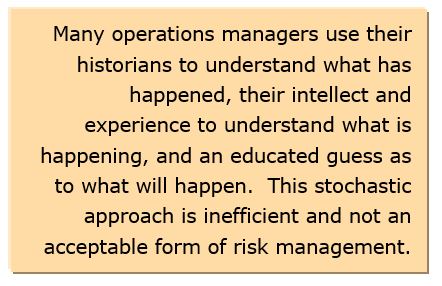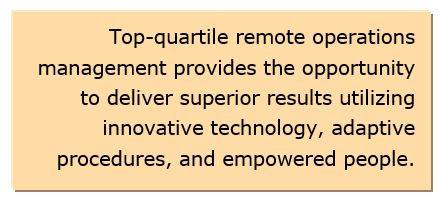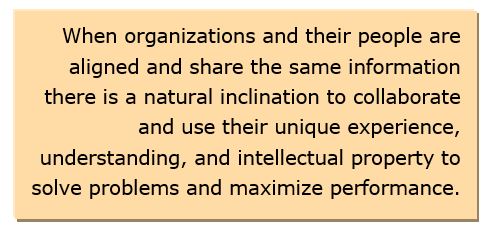

The focus on operating industrial facilities is to maintain steady-state operations despite frequent disturbances, with operators performing whatever is necessary to keep the facilities running and meet production schedules in a safe and environmentally acceptable way. Traditionally, whether the facility is fully manned, minimally manned, or unmanned; its operations are typically 
Although some remote facilities still operate in this manner, the next-generation of remote facilities cannot. The economics of steady-state operations have been replaced with a dynamic economic environment in which adapting to changing supply and demand are the norm. Tighter production specifications, greater economic pressures, and the need to maintain supply reserves, plus more stringent process safety measures, cybersecurity standards, and environmental regulations further challenge this dynamic environment.
Managing these challenges requires more agile, less hierarchical structures; highly collaborative processes; reliable instrumentation; high availability of automation assets; excellent data; efficient information and real-time decision-support systems; accurate and predictive models; and precise control. Uncertainty and risks must be well-understood and well-managed in every aspect of the decision-making process.
Perhaps most importantly, everyone must have a clear understanding of the business objectives and progress toward those objectives. Increasingly, effective remote operations management requires real-time decisions based on a solid understanding of what is happening and the possibilities over the entire operations cycle. Many operations managers use their historians to try to better understand what has happened, their intellect and experience to better understand what is happening, and an educated guess as to what will happen. This stochastic approach is inefficient and, based on ARC Advisory Group research, not acceptable from a risk management perspective. Operations staffs need tools that define precisely what is happening and what will happen. If the current circumstance appears to be leading toward an undesirable result, they also need guidance as to what corrections they need to make to avoid this and when.
Remote operations management involves coordinating a set of manned, minimally manned, or unmanned resources located outside the plant from a distant control room or dispatch center to achieve predetermined results. Remote operations can be found 
“Remote” implies both distance and time. This can be considered a constraint, but also imply breadth and depth, which can provide opportunity. In many respects, remote operations management is similar to traditional process manufacturing and presents similar challenges and opportunities. Both employ many of the same people, processes, and technologies to improve performance. However, ARC believes that current Industrial Internet of Things (IIoT) technologies and solutions offer unique opportunities for users to utilize previously unrealized resources to achieve superior results in remote operations.
Top-quartile remote operations management provides the opportunity to deliver superior results utilizing innovative technology, adaptive procedures, and empowered people. It has the potential to eliminate the time, distance, and organizational constraints that plague traditional approaches while providing individuals across all parts of the organization with a single version of the truth on an "as needed" basis. Knowledge and understanding empower workers, enabling organizations to respond better to dynamic environments and work processes to be more fluid. This can facilitate a higher level of engagement.
Today, many users at both the individual level and across the enterprise need the ability to collaborate and project their understanding based on a single version of the truth. Workers want to harvest all relevant information assets in real time and work collaboratively with colleagues at both their sites and other sites using a comprehensive, state-of-the-art toolset and a common understanding. More importantly, technology available today allows applications to sift through the myriads of data sources instantaneously to provide users with actionable information across the enterprise.

Industry needs to shift to more knowledge workers with unfettered access to data and relationships through tools that can deliver a common and precise understanding of the production cycle in context, which is the foundation for productive collaboration.
ARC believes that the technology required to achieve top-quartile remote operations management is currently available, proven, and constantly improving.
Traditional remote operations management utilized SCADA architectures, which were both hierarchical in nature (with a master station and remote terminal units) and data-centric. This is understandable since they were designed to support rigid organizations and processes. Today’s IIoT-based remote operations management, in contrast, has a flatter architecture and is object- (rather than data-) based. With no master station per se, users have the flexibility to allocate functionality as required, data management is truly distributed, and the data or information are held at the source; eliminating the need for path writing between data sources and users.
Ubiquitous use of TCP/IP networks provides transparency between local and remote resources. Databases are used strictly as sources for trending, record keeping, analysis, etc. This promotes individual initiative in dynamic organizational structures in which everyone with a need to know can share the same information. From a functional view, it also eliminates distance and time barriers.
Remote operations management provide a critical link in a company's overall operations management process. Without effective remote operations management, many enterprises will encounter lost opportunities in resource and supply chain efficiency. Remote management can help increase safety and reduce risk to process, people, and the environment. By leveraging technologies that employ the cloud and associated analytics, companies can also reduce required headcount in the remote area, because it allows specialized skills to be dispatched as problems are foreseen instead of on site to deal with problems after they occur.
Technology is not the issue; it is available and proven. Culture, organization, and securing the right people continue to be the real challenges. However, enterprises with remote “outside the fence” operations need to explore today’s newer IIoT-enabled technologies and solutions and evaluate the potential value they can provide in their own remote operations by improving asset management, asset performance, safety performance, and environmental performance.
ARC has recently published detailed market reports on SCADA for both oil & gas and water & wastewater along with a technology selection guide for oil & gas production facilities and pipelines.
If you would like to buy this report or obtain information about how to become a client, please Contact Us
Keywords: SCADA, Remote Operations Management, Collaboration, Human Assets, ARC Advisory Group.

